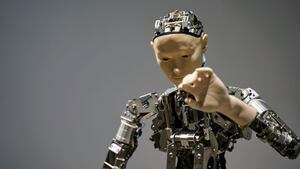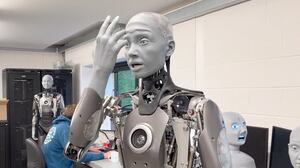Use your hands for a moment. Grab that bottle on your desk and unscrew the cap. Or get a pencil or pen and write your name. You might already be using your hand to read this story on your phone—that works too. As you do, notice each movement that your hands and fingers make, and the tiny changes in pressure you apply as you go through the motions.
Pay close enough attention and you’ll see that your hands are doing a lot more than you realized. But it’s something that you tend not to think about. After all, you’ve probably made these motions countless times in your life.
However, Kenny Shaw thinks about these motions a lot. As a robotics engineer at Carnegie Mellon University, he’s devoted his research to figuring out how hands work—and how to replicate them in machines.
“I've been thinking about this for years now,” Shaw told The Daily Beast. “[To unscrew a bottle,] a humanoid robot’s hand has to act, I’d say, 30 times a second for 20 different joints—and they have to do each of these actions correctly. They just have to do it for two seconds, but that’s already more than 1,000 different actions the robot has to do correctly to unscrew something.”
And that’s just for one action: unscrewing a bottle cap. If you want a robotic hand to do all the things a human hand is capable of, it needs to “know” how to do a near infinite number of actions, according to Shaw. Engineering that kind of robot is complex to say the least, and also expensive: Some robotic hands can cost more than $100,000.
While that number may not mean much to a company like Amazon that might use it to help move and pack items to ship, it’s prohibitively expensive for amputees looking to find a prosthetic limb to replace their hands. That’s why Shaw and his fellow researchers at CMU developed a low-cost robotic hand that can be assembled at home with a 3D printer and a screwdriver. The team even claims that it can outperform its expensive counterparts.
“What we’re really looking at in this paper is how do we make robot hands cheap enough, and reliable enough, that we can do more research with it and just make it more accessible,” Shaw explained. “Because currently, there are very few options out there.”
The Low-Cost, Efficient, and Anthropomorphic (LEAP) Hand costs roughly $2,000 and consists of “readily available parts,” according to a paper presented by the team at the Robotic: Science and Systems conference in July. In tests, the team used the LEAP Hand to grab things like a coffee mug, baseball, soup can, a drill, and a pan. It is able to do even more fine motor skill tasks like opening drawers and stacking cups. The design also allowed it more flexibility than a human hand. For example, it could move each finger and thumb independently up, down, left, right and even rotate.
Using machine learning, the authors were also able to train the hand in order to teleoperate, which means it can mimic the motions of a human using a webcam. This, of course, allows it to have even more applications. Not only can you potentially use the hand to manipulate items in dangerous places like fires or toxic environments, but doctors could also one day use it for remote surgery.
In order to train it, the paper’s authors actually took some inspiration from the training process behind large language models like OpenAI’s ChatGPT. Whereas the popular chatbot was trained on a massive corpus of text from the internet, the LEAP Hand was trained using thousands of YouTube videos showing human hand movement.
“We took a lot of YouTube videos, and used them to teach it to basically do a variety of tasks—picking up different objects, opening doors, using tools—without needing a lot of human demos where the human has to teach the robot directly in the real world,” he said.
Shaw added that all of the information on how to build and train the hand is open source and online so “anyone can build it” if that wanted. This accessibility allows other robotics researchers to improve upon the design or simply use it for their own studies as well.
This is vital because currently there are not a lot of good robotic hands out there. Shaw even noted that Elon Musk’s humanoid robot from Tesla “falls apart” when it comes to the hands. Shaw and his co-author’s goal is to provide a low-cost and accessible machine into the hands of those who truly need it.
“There’s not many people looking at robot hands. It’s actually a pretty small field,” Shaw said. “But I think with these humanoid robots, the ability to do really dexterous tasks will be key for them in the future.”








